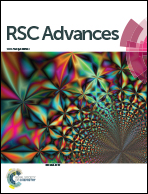Conformational ensembles of neuromedin C reveal a progressive coil-helix transition within a binding-induced folding mechanism†
Abstract
Neuromedin C (NMC) is a peptide that regulates various processes in the central nervous system and gastrointestinal tract through its interaction with the bombesin receptor subtype-2 (BB2R). Hence, BB2R antagonists hold the potential to treat disorders that occur as a result of NMC dysfunction or misregulation. However, their efficient design requires a detailed understanding of the structural features of NMC, which hitherto are unknown. Herein, we describe the conformational ensembles of NMC in an aqueous solution, at five different TFE concentrations to decode its folding pathway and under its SDS micelle bound state. NMC displays a disordered but well defined backbone architecture that undergoes a progressive coil-helix transition with increasing TFE concentration, first at the C-terminus and then at the N-terminus. NMC also adopts a C-terminal α-helical conformation upon binding to SDS micelles. This micelle binding is directed by hydrophobic interactions that concur with the unfavourable deprotonation of His8 and its further insertion into the micelle. Moreover, NMR relaxation data reveal that the acquisition of the micelle bound α-helical conformation constrains the NMC flexibility more than the confinement itself. This comprehensive study of the structural behaviour of NMC provides essential mechanistic information that could be useful for the development of new therapeutics to treat neurological, cancer-related or eating disorders.


 Please wait while we load your content...
Please wait while we load your content...